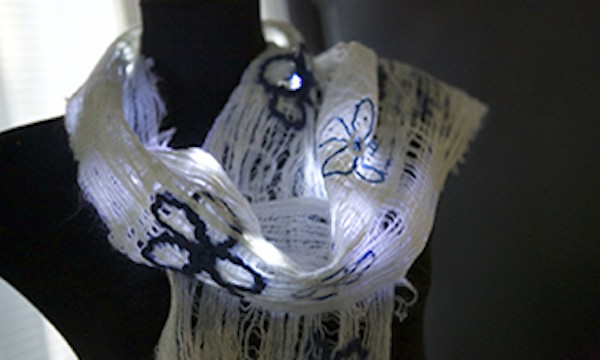
Sonia Reynolds brought the idea to the university’s Advanced Textile Research Group and is further developing the fabric's novel manufacturing process under the direction of Prof Tilak Dias and Dr Amanda Briggs-Goode, of the School of Art and Design.
Unlike traditional woven or knitted materials that are made by the interloping or interlacing of yarns, the new material – dubbed Zephlinear - is made by yarn surface entanglement.
Reynolds said: "This is a real breakthrough for the textiles industry. It's the first non-woven material made from yarn and promises major benefits for the future of clothing, and more.
"Because of the material's linear channels of yarn, it has great potential to be used as a smart textile. In particular, we believe it lends itself well to being embedded with microcapsules containing medication or scent, to either help deliver drugs to specific parts of the body or to create antibacterial and aromatic clothing.
"As the material is visually different, it has potential to be used for other applications as well, such as wall coverings, in addition to clothing.
"And because it's much less labour intensive to make than knit or weave fabrics, it's a more environmentally friendly material to produce as well."
Reynolds presented the patent pending material the Wearable Technology Show, USA. Zephlinear was given the nickname 'space cloth' due to its appearance and its e-textile capabilities.
According to NTU, research shows that it is strongest and most efficient when created from natural yarns such as one hundred per cent wool, hair and wool/silk mixtures, though it can also be made from synthetic yarns.
Professor Dias, who leads the university's Advanced Textiles Research Group, said: "Zephlinear is a remarkable development in an industry which is advancing at an incredible pace.
"We believe it has huge potential for textiles, and we have already found that it combines well with e-textile technologies such as heated textiles or textiles with embedded LEDs.
"As a fabric it is very lightweight and flexible, and it retracts back to its original shape well after it has been stretched.
"We're very much looking forward to developing the material further and feel certain that it will help provide people with smarter and more environmentally friendly clothing in the future."




Red Bull makes hydrogen fuel cell play with AVL
Formula 1 is an anachronistic anomaly where its only cutting edge is in engine development. The rules prohibit any real innovation and there would be...